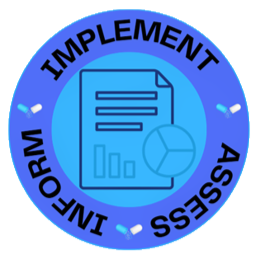
Leveraging National Health Safety Network Antimicrobial Use (AU) Option Data to Inform, Implement and Assess Antimicrobial Stewardship Activities
As a way to demonstrate how AU data can be applied to clinical scenarios, the project team has created a series of stewardship case scenarios. These are all based on real-world examples and focus how NHSN AU data can be used to inform stewardship work. These scenarios are meant to be easily adapted for a variety of use cases such as different SAAR categories or agents.
Category 1: Using AU Data to Identify and Inform Stewardship Opportunities for High Antimicrobial Use
Individual SAAR category
High SAARs for antifungal agents predominantly used for candidiasis are investigated using AU data tools to further define where stewardship efforts could best be leveraged.
Targeted antimicrobial within a SAAR category
Using NHSN AU analytics tools in this case of a high SAAR for antibacterial agents predominantly used for resistant Gram-positive infections allows stewardship efforts to focus on a single agent for targeted intervention.
SAAR category on a targeted unit type.
Using NHSN SAARs for targeted patient populations to design stewardship interventions in these patient populations with special antimicrobial use considerations.
Specific antimicrobial in a select population
Investigating high ceftriaxone use identifies overuse for treatment of presumed urinary tract infections.
Category 2: Using AU Data to Assess Opportunities to Optimize Antimicrobial Use
Intravenous to oral conversions
NHSN AU data are leveraged to track this universal stewardship activity.
De-escalation tracking with AU data
This example uses AU data to track an intervention in pediatric patients to minimize ceftriaxone through switching to more narrow-spectrum agents or stopping unnecessary antimicrobials altogether.
Targeting providers or provider groups
Using new TAS reports to identify provider groups with outlier antimicrobial use rates.
Long antimicrobial durations
Combining AU exports with NHSN data on patient volumes to assess long antimicrobial courses for post-operative antimicrobials.
Guideline adherence
Using data from the TAS reports to assess changes to a targeted prophylaxis guideline for high-risk oncology patients.
Select antimicrobials/SAAR category for a targeted indication
Filtering data on broad spectrum antibacterial agents predominantly used for community-acquired infections to track trends in treatment of community-acquired pneumonia.
Category 3: Using AU Data to Support Other Quality Initiative Implementation
NHSN CDI rates in context of AU data
Combining data from AU and HAI NHSN datasets to demonstrate trends in use of antibacterial agents posing the highest risk for CDI and hospital-onset CDI as part of a collaborative stewardship and infection prevention initiative.
HAI outbreak investigation
Using AU data on agents predominantly used for extensively antibiotic resistant bacteria to inform an ongoing outbreak investigation of catheter related bloodstream infections (CLABSIs) with infection prevention colleagues.
Antimicrobial adverse events
Combining efforts with routine medication harms reporting to determine if certain adverse events are associated with receipt of specific antimicrobials and if use of those antimicrobials is an outlier.
High-cost antimicrobial use reduction
Drilling in on use of a high cost agent, aztreonam, using AU data to inform a cost-savings initiative.
Disclaimer: All data included in the above examples are fabricated and do not represent an individual hospital.
This work was funded by Centers for Disease Control & Prevention Safety and Healthcare Epidemiology Prevention Research Development (SHEPheRD) Program- Contract 2022 Domain 1-A001.

